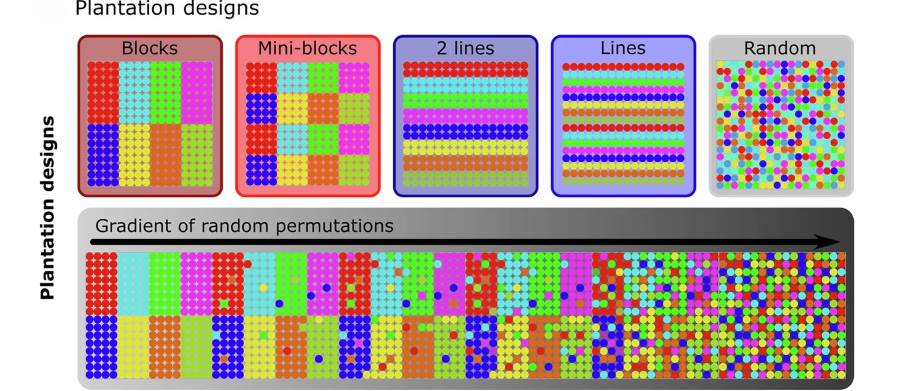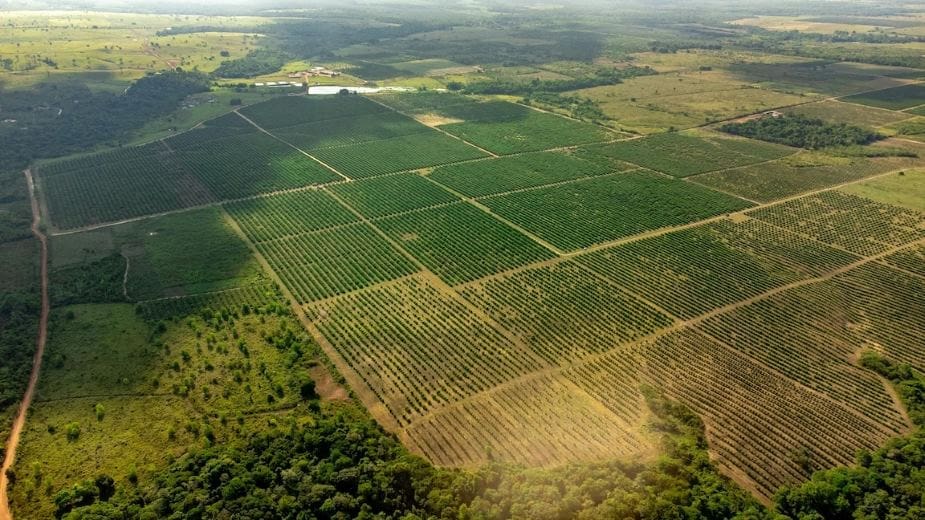Summary:
The spatial arrangement of tree species plays a key role in forest health, according to a study published in Nature Communications. By simulating different planting strategies, an international team of researchers found that the way trees are distributed within a forest – whether clustered, aligned in rows, or randomly scattered – can significantly influence productivity and nutrient cycling. Drawing on empirical data from the large-scale BEF-China experiment, the team modeled how tree growth, leaf litter, and decomposition responded to various spatial designs across eight different tree species.
Their results show that forests with higher species spatial heterogeneity – particularly those with randomly mixed species – produced more biomass, distributed litterfall more evenly, and accelerated carbon and nitrogen cycling. For instance, random planting increased biomass by 11% and raised carbon decomposition rates from 36.5% in block arrangements to 47.1%. Line planting, while less beneficial ecologically, provided a practical balance between ecosystem function and forest management.
Researchers from iDiv, Leipzig University, Friedrich Schiller University Jena, and CNRS suggest that planting design should be explicitly considered in reforestation and afforestation efforts. “We can leverage biodiversity in forests if we arrange it in the right way,” said Nico Eisenhauer of Leipzig University and iDiv.

The right mix and planting pattern of trees enhance forest productivity and services
A new paper reveals how the way tree species are arranged in a forest can help optimize ecosystem functioning and productivity. The study was conducted using empirical field data combined with advanced computer models and simulations by researchers at the German Center for Integrative Biodiversity Research (iDiv), Leipzig University, Friedrich Schiller University Jena, and the French National Center for Scientific Research (CNRS).
The researchers simulated virtual forests with multiple arrangements of tree species, such as block and mini-block designs, plantings in single and double lines, and fully random distributions. These simulations incorporate real data from the BEF-China (Biodiversity-Ecosystem Functioning) experiment, including tree growth models (based on field inventories), litterfall collections, and decomposition rate measurements. This data allowed the researchers to model the effect of spatial arrangement on ecosystem functions, such as tree productivity, nitrogen, and carbon cycling.
If a leaf falls in a randomly arranged forest, there are benefits
The researchers found that the way tree species are arranged in a forest – whether clustered or randomly spread out – impacts productivity. This so-called species spatial heterogeneity, which refers to the patterns of species distribution within a forest, such as block or line planting, affects how nutrients cycle through the ecosystem.
“For decades, biodiversity research has emphasized the benefits of mixing species for productivity and carbon storage. However, this approach is rarely implemented, largely due to the absence of practical guidelines that account for real-world forestry constraints,” explains first author Rémy Beugnon and postdoc at iDiv.
The models show that random planting designs increased tree biomass by 11% compared to clustered layouts. A more even spread of tree species helps promote the even distribution of the fallen leaves, boosting nutrients and organic matter recycling, according to the authors.
The rate of carbon decomposition after nine months also increased with greater spatial heterogeneity, rising from 36.5% of carbon being decomposed in block designs to 47.1% in random designs. Notably, line planting – where alternating rows of different tree species are used – provided a middle ground between ecological benefits and ease of forest management, achieving 40.4% of carbon being decomposed after nine months.
Another key factor is the overall diversity and number of species present in a given forest stand, regardless of their arrangement. More diverse forests, with a wide range of species present, showed higher nitrogen and carbon cycling compared to fewer diverse configurations. This provides a more diverse mix of resources for decomposers and promotes decomposition.
“The combination of experimental analyzes and predictive modeling could be used to evaluate different scenarios of forest management. Besides the experimental validation of these findings, an important next step will be to know how general our conclusions are and whether they apply to different types of forests,” explains co-author Benoit Gauzens of iDiv and the University of Jena.
The perks of line planting
From a practical standpoint, the researchers note the balance required between securing ecological benefits and forest management. While random planting designs maximize ecological outcomes – including more biodiversity, enhanced nutrient cycling, and carbon sequestration – line planting offers a manageable compromise, simplifying tasks like thinning and harvesting.
Looking ahead, researchers envision extending these computer-based findings by conducting long-term field experiments to validate the study’s results in real-world contexts. Such trials would further investigate the interaction between tree species diversity, spatial arrangement, and ecosystem function, helping develop new approaches to reforestation and sustainable forestry.
“This study is an important example of how basic research can inform management applications under field conditions: we can leverage biodiversity in forests if we arrange it in the right way,” says Nico Eisenhauer, professor at Leipzig University and group head at iDiv. “Moreover, we see how local interactions between trees, their microclimate, and soil biodiversity can scale up to enhance multiple ecosystem services in forests,” he concludes.
Journal Reference:
Beugnon R. , Albert G., Hähn G., Yu W., Haider S., Habenschwiler S., Davrinche A., Rosenbaum B., Gauzens B., Eisenhauer N., ‘Improving forest ecosystem functions by optimizing tree species spatial arrangement’, Nature Communications 16, 6286 (2025). DOI: 10.1038/s41467-025-61389-7
Article Source:
Press Release/Material by German Centre for Integrative Biodiversity Research (iDiv) Halle-Jena-Leipzig
Featured image: Block plantations like these may look efficient, but research shows that more diverse and randomised tree arrangements boost forest productivity and ecosystem health. Credit: M. Silva




